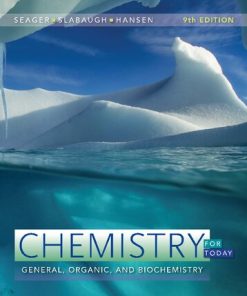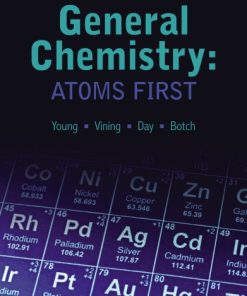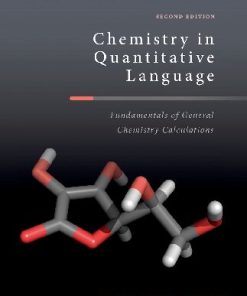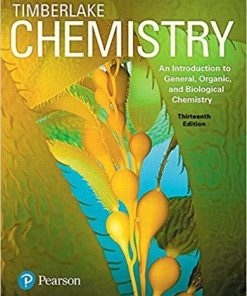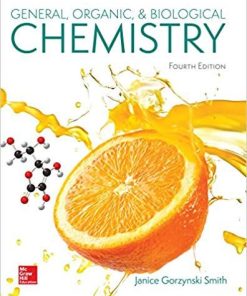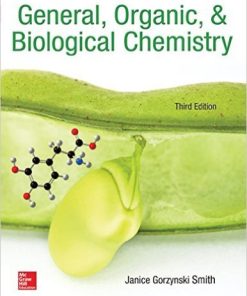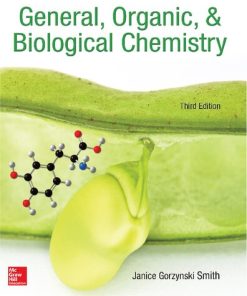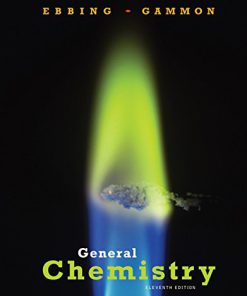(Ebook PDF) General chemistry for engineers 1st edition by Jeffrey Gaffney, Nancy Marley ISBN 9780128104446 0128104449 full chapters
$50.00 Original price was: $50.00.$25.00Current price is: $25.00.
(Ebook PDF) General chemistry for engineers 1st edition by Jeffrey Gaffney, Nancy Marley-Ebook PDF Instant Download/Delivery:9780128104446, 0128104449
Instant download Full Chapter of General chemistry for engineers 1st edition after payment
Product details:
ISBN 10:0128104449
ISBN 13:9780128104446
Author: Jeffrey Gaffney; Nancy Marley
General Chemistry for Engineers explores the key areas of chemistry needed for engineers. This book develops material from the basics to more advanced areas in a systematic fashion. As the material is presented, case studies relevant to engineering are included that demonstrate the strong link between chemistry and the various areas of engineering.
- Serves as a unique chemistry reference source for professional engineers
- Provides the chemistry principles required by various engineering disciplines
- Begins with an ‘atoms first’ approach, building from the simple to the more complex chemical concepts
- Includes engineering case studies connecting chemical principles to solving actual engineering problems
- Links chemistry to contemporary issues related to the interface between chemistry and engineering practices
Table of Contents:
- Chapter 1: Introduction
- Abstract
- 1.1 The Role of Chemistry in Engineering
- 1.2 Green Engineering
- 1.3 Measurement and Calculations
- 1.4 The Physical States of Matter
- 1.5 Classification of Matter
- 1.6 Separation of Mixtures
- Important Terms
- Study Questions
- Problems
- Chapter 2: The Periodic Table of the Elements
- Abstract
- 2.1 Atomic Structure
- 2.2 The Shell Model of the Atom
- 2.3 Electron Assignments
- 2.4 The Periodic Table of the Elements
- 2.5 Periodic Trends
- Important Terms
- Study Questions
- Problems
- Chapter 3: Chemical Bonding—The Formation of Materials
- Abstract
- 3.1 Atoms and Ions
- 3.2 Ionic Bonding
- 3.3 Covalent Bonding
- 3.4 Mixed Covalent/Ionic Bonding
- 3.5 Molecular Orbitals
- 3.6 Molecular Geometry
- 3.7 Molecular Polarity
- 3.8 Intermolecular Forces
- Important Terms
- Study Questions
- Problems
- Chapter 4: Chemical Equations and Mass Balance
- Abstract
- 4.1 The Mole
- 4.2 The Empirical Formula
- 4.3 Chemical Equations
- 4.4 Stoichiometry
- 4.5 Limiting Reactant and Percent Yield
- 4.6 Aqueous Solubility of Ionic Compounds
- 4.7 Precipitation Reactions in Aqueous Solution
- 4.8 Concentrations in Aqueous Solution
- Important Terms
- Study Questions
- Problems
- Chapter 5: Acids and Bases
- Abstract
- 5.1 Defining Acids and Bases
- 5.2 Acids and Bases in Aqueous Solution
- 5.3 The pH Scale
- 5.4 Other “p” Functions
- 5.5 Buffer Solutions
- 5.6 The Titration
- Important Terms
- Study Questions
- Problems
- Chapter 6: Properties of Gases
- Abstract
- 6.1 A Historical Perspective
- 6.2 Boyle’s Law
- 6.3 Charles’ Law
- 6.4 Gay-Lussac’s Law
- 6.5 The Ideal Gas Law
- 6.6 Nonideal Gas Behavior
- 6.7 Partial Pressures
- 6.8 Chemical Reactions With Gases
- Important Terms
- Study Questions
- Problems
- Chapter 7: Chemical Equilibrium
- Abstract
- 7.1 Reversible Reactions
- 7.2 The Equilibrium Constant
- 7.3 Relationships Between Equilibrium Constants
- 7.4 Le Chatelier’s Principle: Disturbing a Chemical Equilibrium
- 7.5 The Reaction Quotient
- Important Terms
- Study Questions
- Problems
- Chapter 8: Thermodynamics and Energy Balance
- Abstract
- 8.1 Chemical Thermodynamics
- 8.2 The First Law of Thermodynamics: Heat and Work
- 8.3 Enthalpy
- 8.4 Standard Enthalpies
- 8.5 Bond Enthalpy
- 8.6 The Second Law of Thermodynamics: Entropy
- 8.7 The Third Law of Thermodynamics: Entropy and Temperature
- 8.8 Gibbs Free Energy
- 8.9 Standard Gibb Free Energies and Chemical Equilibrium
- Important Terms
- Study Questions
- Problems
- Chapter 9: Kinetics and the Rate of Chemical Reactions
- Abstract
- 9.1 Reaction Rate
- 9.2 Rate Laws
- 9.3 Integrated Rate Laws
- 9.4 Half-Life
- 9.5 Collision Theory
- 9.6 Reaction Mechanisms
- 9.7 Chain Reaction Mechanisms
- Important Terms
- Study Questions
- Problems
- Chapter 10: Oxidation-Reduction Reactions and Electrochemistry
- Abstract
- 10.1 Oxidation-Reduction Reactions
- 10.2 The Galvanic Cell
- 10.3 Balancing Oxidation-Reduction Equations
- 10.4 Standard Cell Potentials
- 10.5 Reactions at Nonstandard Conditions: The Nernst Equation
- 10.6 Electrolysis
- 10.7 Batteries
- 10.8 Fuel Cells
- Important Terms
- Study Questions
- Problems
- Chapter 11: Solids
- Abstract
- 11.1 Crystalline Solids
- 11.2 Ionic Solids
- 11.3 Molecular Solids
- 11.4 Atomic Solids
- 11.5 Metallic Solids
- 11.6 Amorphous Solids
- Important Terms
- Study Questions
- Problems
- Chapter 12: Solution Chemistry
- Abstract
- 12.1 Solution Composition
- 12.2 Dissolution
- 12.3 The Effect of Pressure on Solubility
- 12.4 The Effects of Temperature on Solubility
- 12.5 Solubility of Ionic Solids
- 12.6 Complexing Agents
- 12.7 Surfactants
- 12.8 Colligative Properties
- Important Terms
- Study Questions
- Problems
- Chapter 13: The Chemistry of Carbon
- Abstract
- 13.1 Carbon Bonding and Hybridization
- 13.2 Organic Hydrocarbons: Alkanes, Alkynes, Alkenes, and Aromatics
- 13.3 Organic Functional Groups
- 13.4 Organic Reaction Mechanisms
- 13.5 Polymer Chemistry
- Important Terms
- Study Questions
- Problems
- Chapter 14: Nuclear and Radiochemistry
- Abstract
- 14.1 Isotopes and Radioactive Decay
- 14.2 Radioactive Decay Rates and Half Lives
- 14.3 Natural Radioisotopes
- 14.4 Detecting Radioisotopes and Radioactivity
- 14.5 Fission and Fusion
- 14.6 Nuclear Energy
- 14.7 Radiation Safety
- 14.8 Applications of Radioisotopes
- Important Terms
- Study Questions
- Problems
- Chapter 15: Chemical Measurements and Instrumentation
- Abstract
- 15.1 Chromatography
- 15.2 Atomic Spectroscopy
- 15.3 UV-Visible Absorption Spectroscopy
- 15.4 Infrared Spectroscopy
- 15.5 Luminescence Spectroscopy
- 15.6 Mass Spectrometry
- 15.7 Nuclear Magnetic Resonance Spectroscopy
People also search:
general chemistry for engineers griffith
general chemistry for engineers pdf
general chemistry for engineers rutgers
cm uy 1003 general chemistry for engineers
chm 114 general chemistry for engineers
Tags:
Jeffrey Gaffney,Nancy Marley,General Chemistry,Engineers
You may also like…
Uncategorized
(Original PDF) Chemistry: An Introduction to General, Organic, and Biological Chemistry 13th Edition
Uncategorized





